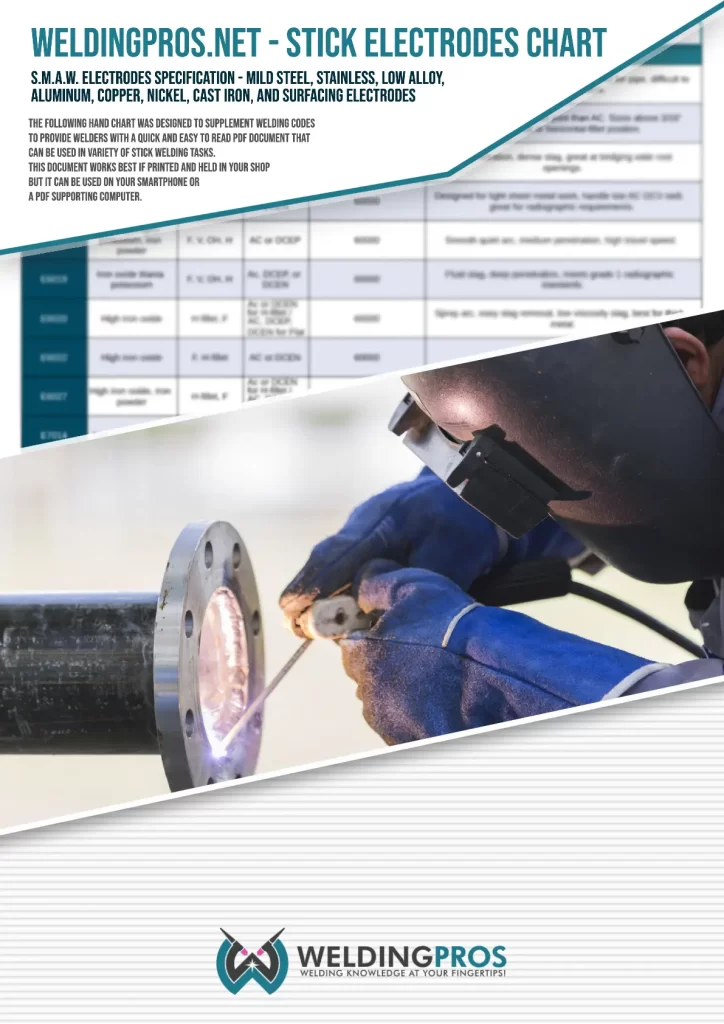The calculator below pinpoints exactly which electrode you need for the metal you are welding. You will also get the required polarity, position, and other related information.
Additionally, we made the most complete stick welding rod chart PDF on the internet with over 220 electrodes. You can get it for free below.
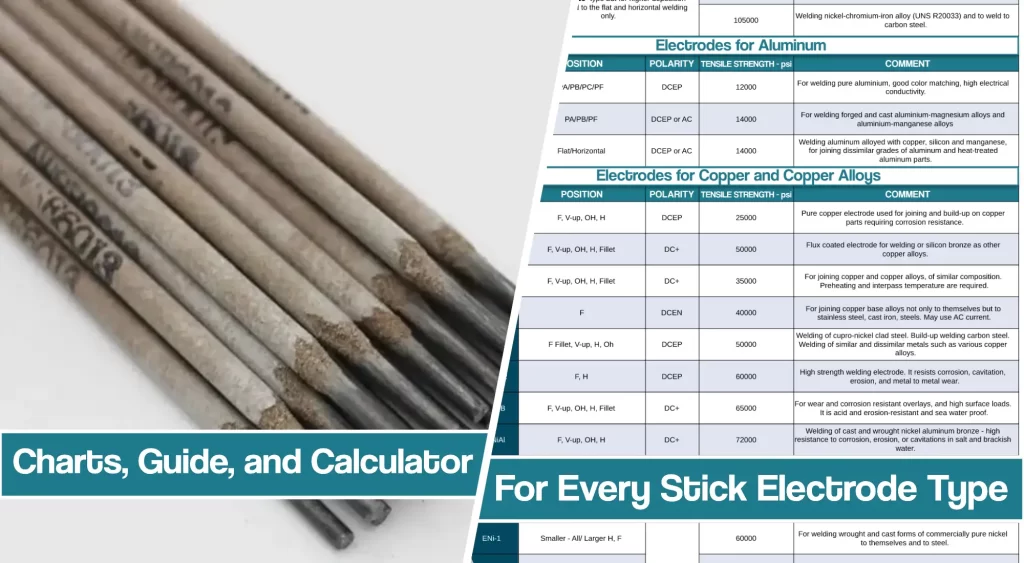
In this article, you will learn about the stick electrodes, how to choose which one you need, and get a vast amount of free resources we put together. As welders, we were frustrated how no one combined all of the stick electrode charts in one place, so we did it ourselves.
This page is structured as follows:
- Electrode calculator
- Free stick welding electrodes PDF chart
- Welding rod sizes and amperage chart (article only – no PDF for now)
- Selection guide teaching you everything you need to know about stick welding electrodes
The guide is at the bottom of all the resources because we assume most welders know the basics, but if you don’t, you can check it out before using the calculator or downloading the charts.
Stick Welding Electrode Selection Calculator
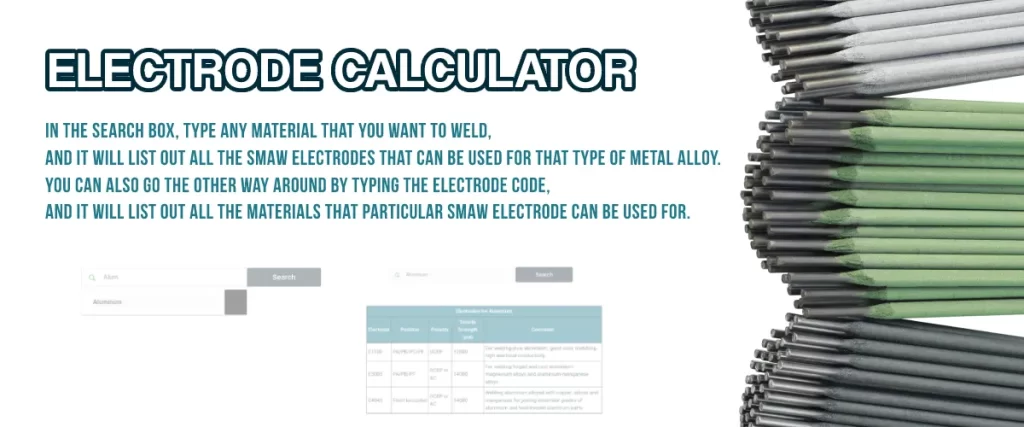
Stick Welding Electrodes PDF Chart
In this welding rod chart, you will find over 220 stick electrodes classified according to the American Welding Society (AWS) code.
The PDF has 8 sections:
- Electrodes for mild steel
- Electrodes for low alloy steel
- Electrodes for stainless steel
- Electrodes for aluminum
- Electrodes for copper and copper alloys
- Electrodes for nickel and nickel alloys
- Electrodes for cast iron
- Electrodes for surfacing
Each section covers all AWS-specified electrodes and provides the needed information. We included the coating, position, polarity, tensile strength, and most importantly, a valuable comment to help you better understand every welding rod.
We worked hard on this PDF chart and hired multiple people to help us put this thing together. It's well designed, visually accessible, and works best if printed and kept in your shop or another work area. But it's also light for use with a smartphone.
Welding Rod Sizes and Amperage Chart
We'll cover only mild steel rods for the shielded metal arc welding electrode size and amperage chart. If we covered all 220 electrodes as we did in the PDF above, the chart would have thousands of lines, which wouldn't be practical.
The chart below covers all of the most used welding rods like E6010, E6011, E6013, E7018, etc.
| Electrode diameter (in.) | E6010, E6011 | E6012 | E6013 | E6019 | E6020 | E6022 | E6027, E7027 | E7014 | E7015, E7016 | E6018, E7018, E7018M | E7024, E7028 | E7048 |
|---|---|---|---|---|---|---|---|---|---|---|---|---|
| 1/16 | N.A. | 20 - 40A | 20 - 40A | N.A. | N.A. | N.A. | N.A. | N.A. | N.A. | N.A. | N.A. | N.A. |
| 5/64 | N.A. | 25 - 60A | 25 - 60A | 35 - 55A | N.A. | N.A. | N.A. | N.A. | N.A. | N.A. | N.A. | N.A. |
| 3/32 | 40 - 80A | 35- 85A | 45 - 90A | 50 - 90A | N.A. | N.A. | N.A. | 80 - 125A | 65 - 110A | 70 - 110A | 100 - 145A | N.A. |
| 1/8 | 75 - 125A | 80 - 140A | 80 - 130A | 80 - 140A | 100 - 150A | 110 - 160A | 125 - 185A | 110 - 160A | 100 - 150A | 105 - 155A | 140 - 190A | 80 - 140A |
| 5/32 | 110 - 170A | 110 - 190A | 105 - 180A | 130 - 190A | 130A - 190A | 140 - 190A | 160 - 240A | 150 - 210A | 140 - 200A | 130 - 200A | 180 - 250A | 150 - 220A |
| 3/16 | 140 - 215A | 140 - 240A | 150 - 230A | 190 - 250A | 175 - 250A | 170 - 400A | 210 - 300A | 200 - 275A | 180 - 255A | 200 - 275A | 230 - 305A | 210 - 270A |
| 7/32 | 170 - 250A | 200 - 320A | 210 - 300A | 240 - 310A | 225 - 310A | 370 - 520A | 250 - 350A | 260 - 340A | 240 - 320A | 260 - 340A | 275 - 365A | N.A. |
| 1/4 | 210 - 320A | 250 - 400A | 250 - 350A | 310 - 360A | 275 - 375A | N.A. | 300 - 420A | 330 - 415A | 300 - 390A | 315 - 400A | 335 - 430A | N.A. |
| 5/16 | 275 - 425A | 300 - 500A | 320 - 430A | 360 - 410A | 340 - 450A | N.A. | 375 - 475A | 390 - 500A | 375 - 475A | 375 - 470A | 400 - 525A | N.A. |
Stick Welding Rods Selection Guide
Choice of a stick welding electrode is often specified in the Welding Procedure Specification (WPS), but if you are new to stick arc welding, or the job doesn't define the electrode, this guide will help you make the right choice.
The two main differences between arc welding electrodes are the flux covering and the core filler metal. There are many different coatings, and the filler rod inside the flux can be alloyed with a specific mixture of additives.
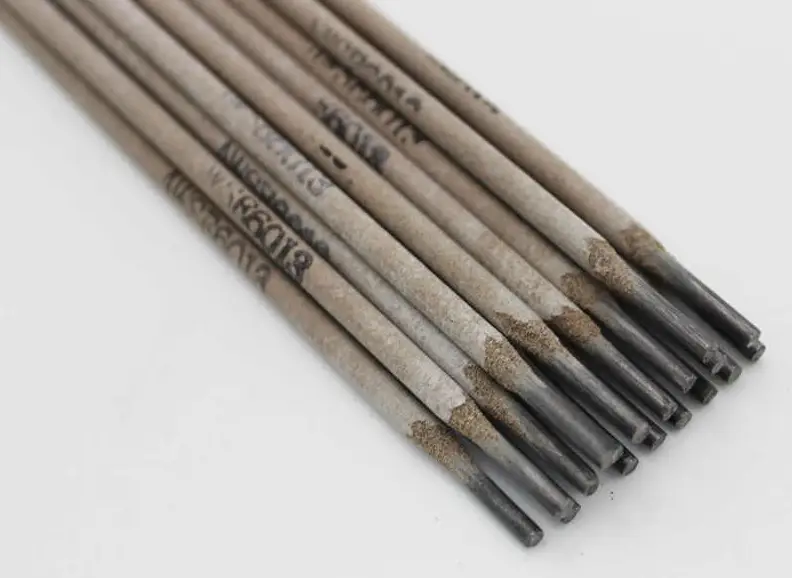
Each welding rod is designed to work best in specific scenarios. Some rods can handle other welding work than they are intended for, but with limitations, while others can't handle anything other than their intended purpose. That's why you should make sure you choose the suitable electrode for both your job and your stick/arc welder.
A flux coating will determine the slag and arc characteristics, required polarity, and possible welding positions. The filler metal will also influence the arc, but it will determine the tensile strength and bond made between the welded pieces. Some exotic metals like nickel require specific rods for very specific tasks, while electrodes for welding mild steel are laxer in their application.
So let's start with the primary welding rods classification.
Shielded Metal Arc Welding Rods Classification
The welding industry has adopted the American Welding Society (AWS) codes and standards for classifying stick welding electrodes.
The AWS codes are:
- A5.1 - carbon steel
- A5.5 - low-alloy steels
- A5.4 - stainless steel
- A5.15 - cast iron welding
- A5.11 - nickel alloys electrodes
- A5.3 - aluminum alloys
- A5.6 - copper alloys
- A5.13 - electrodes for surfacing alloys
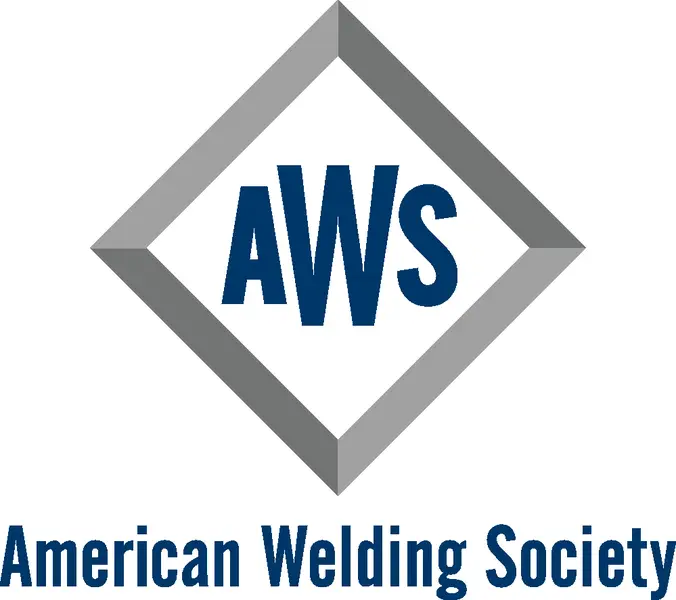
The most commonly welded metal is low carbon steel or, otherwise referred to, mild steel. So we will be looking at the A5.1 AWS specification for carbon steel electrodes.
Let's analyze the E7018 stick arc welding electrode as an example of how AWS specifies the mandatory classification designators.
- E - The first letter, "E" stands for an electrode. This may be omitted from the product imprint.
- The first two digits indicate the minimum tensile strength of the produced weld metal expressed in ksi (MPa/10). In this case, the "70" stands for 70 ksi or 70,000 psi.
- The third digit indicates the recommended welding position. The number "1" means that it's an all-position electrode; "2" is used for horizontal and flat positions; 3 if for a flat position; 4 allows for all positions but limits the vertical travel to downwards only.
- The fourth digit indicates the flux coating and the required current type. The current can be alternating, direct current electrode positive (DCEP), or direct current electrode negative (DCEN). All coating types for mild steel electrodes are in the table below.
- Additionally, if the electrode contains a letter "M" like E7018M, that indicates that it's designed to meet most military requirements. It has a higher toughness, lower moisture content, and mandatory diffusible hydrogen limits.
- If the electrode has a suffix "-1", like E7018-1, the electrode meets the requirements for improved toughness and ductility.
- A suffix of "HZ," E7018HZ, designates that the electrode meets an optional supplemental test for hydrogen diffusion. These electrodes are safer when maximum hydrogen diffusability is a must.
So, let's look at another example of E6010. We can conclude the following: It's an electrode (E), the tensile strength of the produced weld is 60 ksi or 60,000psi (60), we can weld with it in all positions (1), the coating type is high cellulose sodium and the required current is DCEP (0 - check table below).
Stick Welding Electrode Coating Types and Current Type for Mild Steel Electrodes
| Number | Coating type | Current type |
|---|---|---|
| 0 | High cellulose sodium | DC+ |
| 1 | High cellulose potassium | AC, DC+ or DC- |
| 2 | High titania sodium | AC, DC- |
| 3 | High titania potassium | AC, DC+ |
| 4 | Iron powder, titania | AC, DC+ or DC- |
| 5 | Low hydrogen sodium | DC+ |
| 6 | Low hydrogen potassium | AC, DC+ |
| 7 | High iron oxide, iron powder | AC, DC+ or DC- |
| 9 | Low hydrogen potassium, iron powder | AC, DC+ or DC- |
Most stick welding electrodes can be divided into three groups by coating types. These are cellulosic, rutile, and basic coatings.
| Electrode Type | Main Constituent | Resulting Shielding Gas |
|---|---|---|
| Cellulosic | Cellulose | Hydrogen + CO2 |
| Basic | Calcium compounds | Mainly CO2 |
| Rutile | Titania (TiO2) | Mainly CO2 |
Don't be confused when you see the 6010 and 6011 as "high cellulose" and having different second parameters as sodium or potassium. They are both cellulosic, but the other additions to the covering provide different results. The same goes for rutile and basic coatings.
Cellulose-Based Flux
Cellulosic electrodes produce welds with a thin slag giving you a clearer view of the weld puddle. These electrodes make achieving a complete root fusion much easier, especially in vertical, horizontal, and overhead positions.
However, more welding fumes and sparks are created compared to rutile and basic welding rods.
Cellulose-based stick electrodes like E6010 are challenging to operate by inexperienced welders. They are meant for heavy-duty applications like pipe welding.
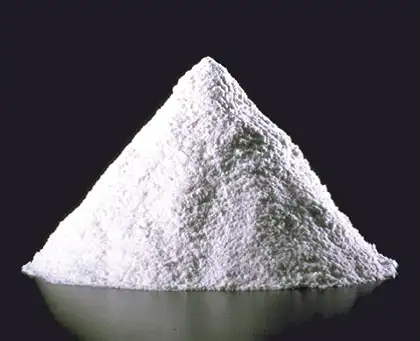
The E6010 are also referred to as "stove pipe electrodes" because of their ability to weld in the stove piping position (vertical down). Welding in this position enhances the weld and improves productivity because the slag cools faster.
The deep penetration, high deposition rate, and the ability to weld vertically downwards make the cellulosic electrodes perfect for pipe welding and working on storage tanks. But they also have their use in industrial settings with certain limitations typically specified in the WPS.
These electrodes contain over 30% of cellulose in their coating, typically in the form of wood flour. They have a moisture content of about 4-5%, which produces a large amount of hydrogen when burning. This hydrogen raises the arc voltage and is responsible for their deep penetration and high deposition rate. However, this requires high open-circuit voltage (OCV), making these electrodes tough to run on a cheap inverter stick welder.
Rutile-Based Flux
Rutile stick electrodes have a smoother arc and produce fewer sparks and welding fumes than cellulosic electrodes. The rutile-based are the best electrodes for beginners, thanks to their favorable welding characteristics.
The titanium dioxide present in the rutile electrodes provides a smooth bead surface, easy slag removal, and stabilizes the arc.
However, they have a heavier slag than the cellulosic electrodes, which can obstruct your view and buildup in the joint.
This can prevent a complete root fusion. Additionally, they contain high amounts of hydrogen, just like the cellulosic electrodes. So they shouldn't be used when welding high-carbon steel.
Basic or Low Hydrogen Stick Electrodes
Basic stick welding rods coatings contain high amounts of calcium carbonate and iron powder. These electrodes have a minuscule amount of moisture, and that's why they are referred to as low hydrogen.
Basic electrodes are used for critical welds in high-strength steel constructions like ships, bridges, offshore oil and gas applications because they produce strong welds without cracking.
Low hydrogen electrodes have excellent mechanical properties and provide medium penetration. They are easier to run on dirtier metal thanks to the additions like silicon, iron powder, and manganese. And have good arc starts and restarts.
These electrodes must be kept in a hermetically sealed container and baked in specialized stick electrode ovens before their use. This is not a must if you are a hobbyist welder, but if doing things by the code, especially for critical welds.
Classification of Stick Electrode Coating Ingredients
The overall combination of coating ingredients determines if the electrode is cellulosic, basic, or rutile. But it also determines the electrode's characteristics since not all electrodes are the same within their type, i.e., E6010 is not the same as E6011 even if both are cellulosic.
These coating materials are classified into the following groups:
Alloying Elements
The electrode can have different alloying elements like nickel, chromium, molybdenum, manganese, and others that impact the mechanical properties of the resulting weld metal. If the mechanical properties are of great concern, you should see the specification sheet of the welding rods you plan to use. If the alloying elements are not provided in the specs, you should contact the manufacturer.
Binders
Binders form the plastic mass of the coating and are hard enough to maintain a crater and not spall, chip, or crack. Soluble silicates like sodium and potassium are used in the electrode coating as binders.
Gas Formers
Stick electrodes use the carbohydrates hydrates and carbonates as gas-forming materials. For example, cellulose like the wood flock, the carbonates of calcium and magnesium, or the chemically combined water as found in clay and mica. The free moisture is another gas former, and it's found in cellulosic electrodes in amounts of 2-3%.
These gas-forming agents evolve carbon dioxide CO2, carbon monoxide CO, and water vapor H2O at the welding arc temperature. These gasses provide the shielding action of the weld pool from oxidation and contamination.
Arc Stabilizers
The most used arc stabilizers are titanium, potassium, and calcium compounds. They provide the necessary conductive path for the flow of current because the air is not conducive enough on its own. For example, titanium dioxide found in rutile electrodes is responsible for their smooth arc characteristics, thanks to the improved conductivity it provides.
In addition, since many welders struggled to master maintaining or striking an arc with a specific electrode, the latest arc welders offer anti-stick or smooth start features. So when combined with arc stabilizers in electrodes, stick welder features will ensure positive results.
Fluxes and Slag Formers
Silica and magnetite are typically used ingredients that give body to the slag and properties like surface tension, melting point, and viscosity.
Plasticizers
Plasticizers are lubricating materials that make the coating flow smoothly under pressure. Since coatings are often granular or sandy, adding sodium and potassium carbonates as plasticizers is necessary.
Welding Position
Some welding electrodes allow for all position welding; some are limited to flat and horizontal positions, while other welding rods are meant for specific positions like vertical-down, vertical-up, or flat.
The welding position depends mainly on the electrode coating. For example, the E6020 electrode's coating consists primarily of iron oxide and has a high deposition rate. As a result, the weld is very fluid, limiting it to flat and horizontal welding only.
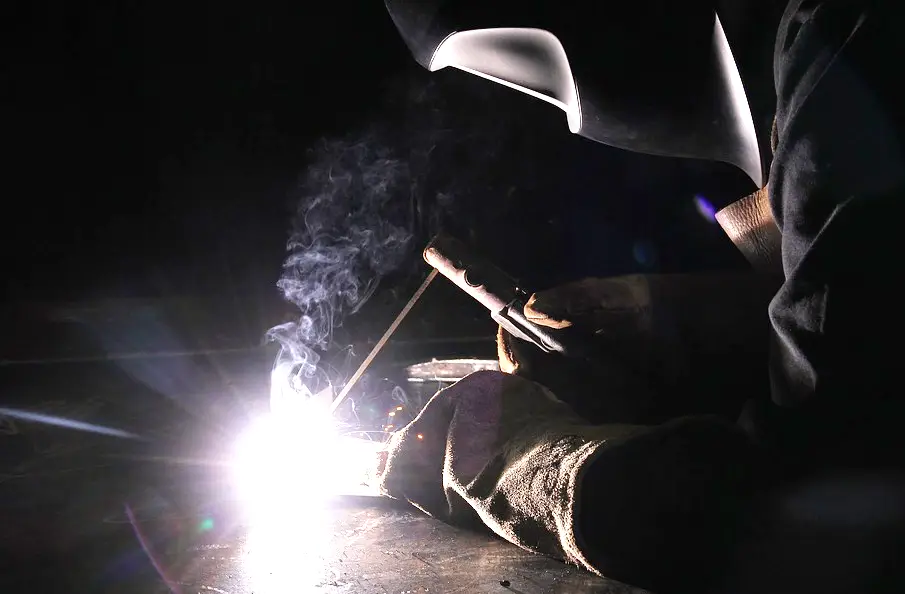
On the other hand, E7018 has a very balanced set of ingredients for the coating. Its deposition rate is optimal for most use cases and can be used in all-position welding even if it contains a considerable amount of iron oxide.
But its bigger brother E7028, with a much higher iron oxide content and a significantly higher deposition rate, is suitable for a flat position and horizontal position fillet welding only. The E7048 behaves like the E7018, but it's designed for excellent vertical down welding.
So, it's crucial to choose a welding rod that matches your required welding position. All welding position rods are your best bet, but if you need a specialized electrode, make sure it's applicable to your welding projects.
If you wish to learn how to stick weld, we have a dedicated article on the topic where we cover the techniques and other important details.
Polarity
The welding rod polarity is determined by coating type, as shown in the table before or in the PDF above.
When shielded metal arc welding, it's important to know why you want to use DCEN, DCEP, or AC current.
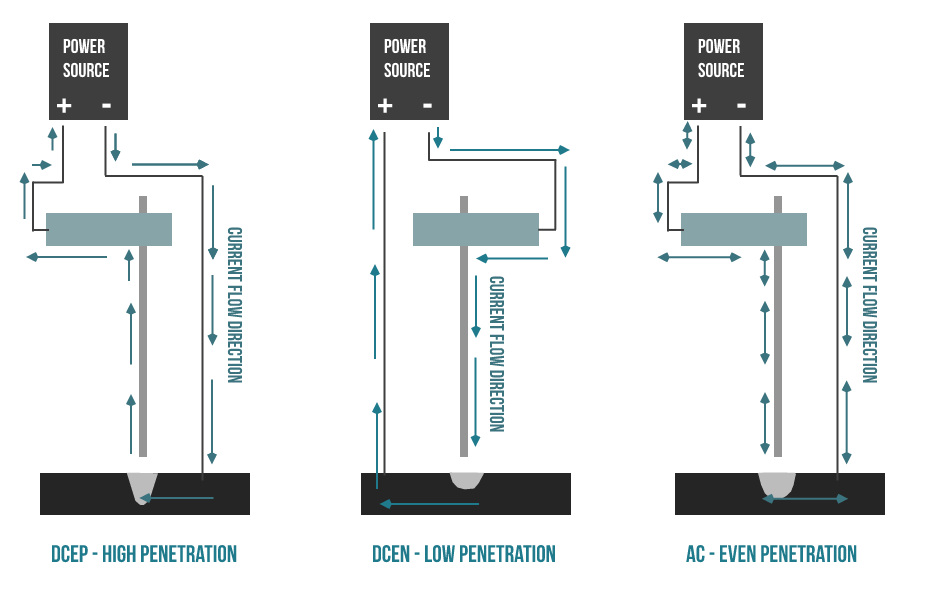
DCEP creates better penetration, and it's typically used for joints where maximum fusion is desired. However, DCEN is a preferred choice if you are welding thinner sheet metals or if working on open root welds. Since DCEN has weaker penetration, it also has lesser chances of burn-through. DCEN is also used when making surfacing welds to prevent extreme penetration.
While DC is almost always the preferred choice, sometimes AC is the only option. You could be limited by an AC-only stick welder. However, AC is often the choice when welding at a great distance between the welded piece and the power source. The DC voltage will drop if the leads are too long while the AC doesn't have this problem. You can learn more about the AC and DC welding differences in our separate article.
Commonly Used Shielded Metal Arc Welding Rods
Now let's take a deeper dive into each of the commonly used welding rods.
I will only cover the electrodes for welding carbon steel. You can get the PDF chart if you wish to see a concise comment on every electrode for every material. But, writing in-depth about every electrode that exists would require writing a book series.
Stick Welding Electrodes Penetration Comparison Chart
The chart below compares fillet welds penetration to the base metal. The different stick electrodes are compared in a general manner. Many variables can produce completely different results so take this as a general rule of thumb, not indisputable facts.
Everything from travel speed, stick welder power output and voltage consistency, your technique, and skills, to ambient factors like outside temperature, can and will influence the actual results. The charts below show different rates of penetration and metal deposition but please take variables into consideration.
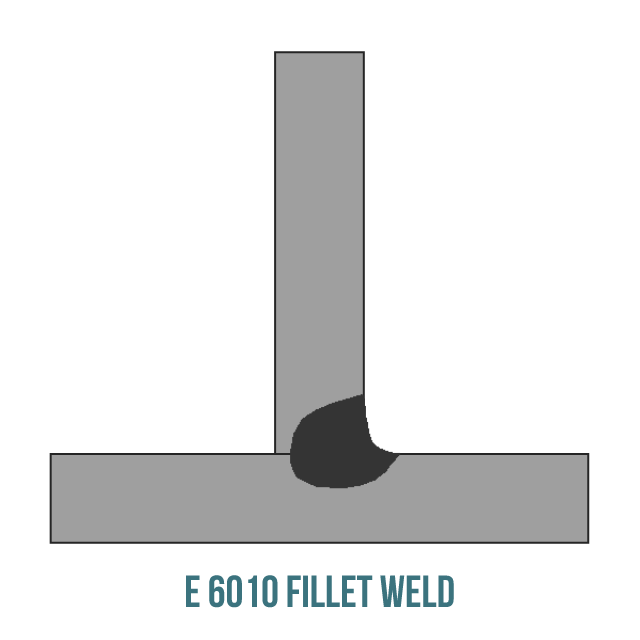
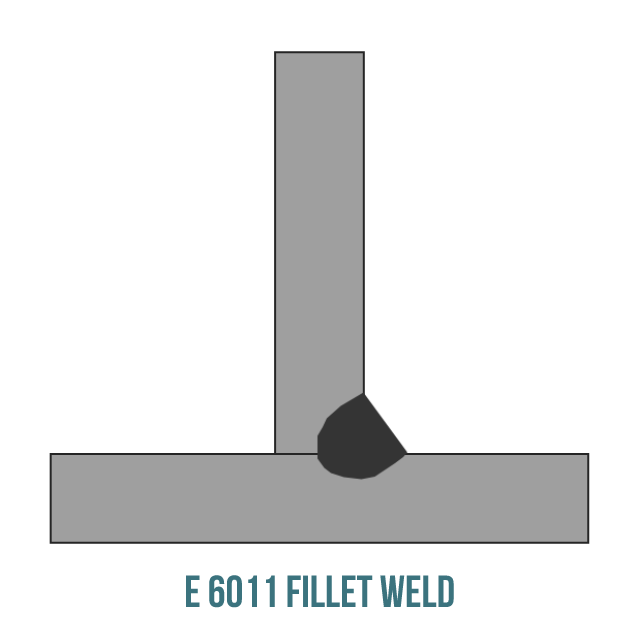
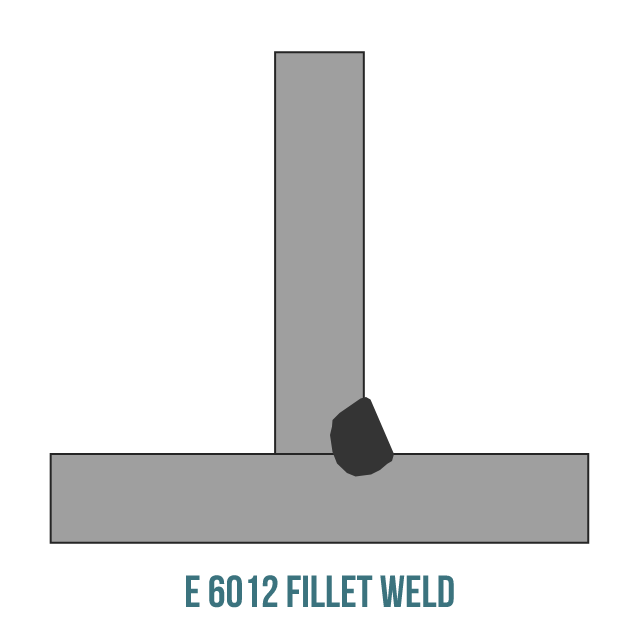
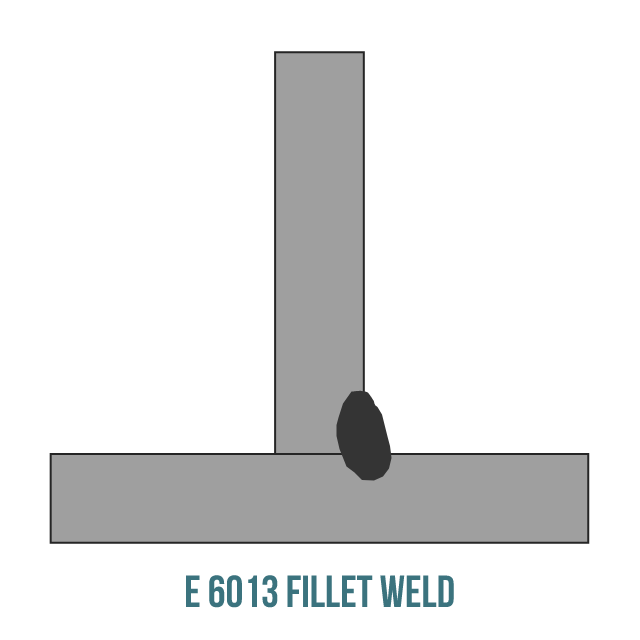
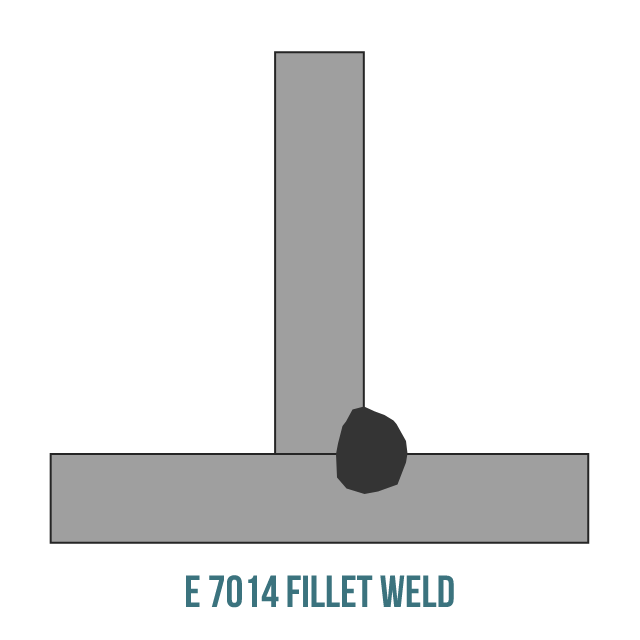
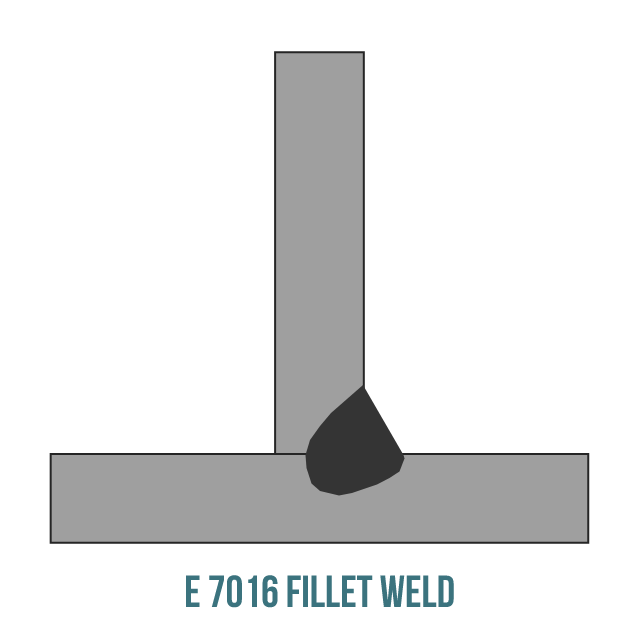
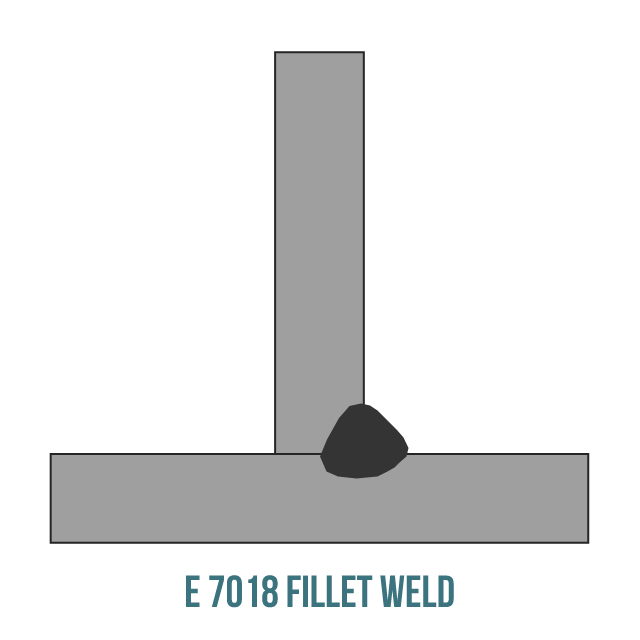
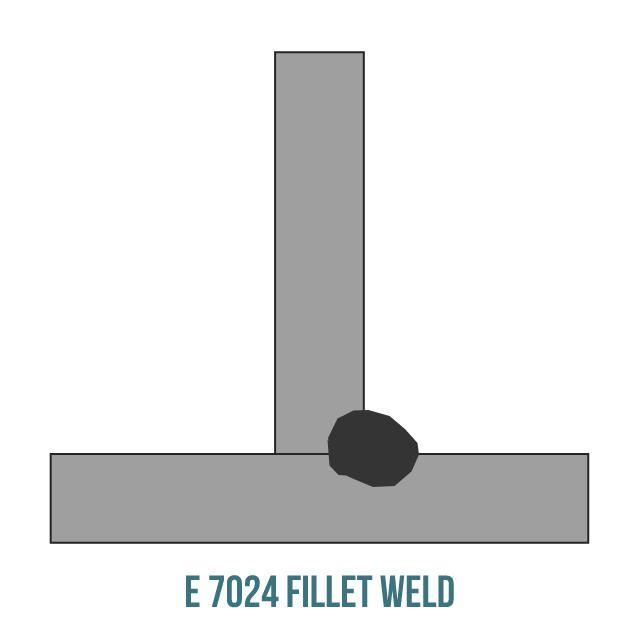
E6010 Stick Welding Electrode
The E6010 welding rods were initially created for improved welding operation. However, the E6010 is usually used in heavy applications like pipe and structural welding today.
The most notable characteristic is its deep arc penetration. Thanks to their cellulosic coating and high hydrogen content, their arc gets an additional voltage push which helps them dig deep in the metal.
Apart from excellent penetration, they can be used to cut metal. You can create a torch to slice up the steel like butter by cranking up your welder to maximum amperage output. The possible cutting base metal thickness depends a lot on the electrode's diameter and the amperage of your welding machine. The cut won't be clean, but it does the job in a hurry.
The E6010 welding rods burn at a fast pace. They deposit metal quickly, making them an excellent choice for bridging wide root openings and welding joists. It's a much faster electrode than E7018, but this is not always a good thing. When the joint requires a careful metal deposition, it's not a good idea to deposit a lot of filler metal as fast as you can.
However, due to the aggressive arc intended for heavy applications, many welders struggle to strike or maintain an arc with 6010s. That's why you should make sure your stick/arc welder is capable of burning them. Luckily, many latest stick welders offer features that stabilize an arc, so feel free to check the best stick welders we recommend.
The coating is mainly made of wood flour with the addition of mineral silicates, deoxidizers, and sodium silicate. The slag is minimal, and it's easy to remove. Due to their high cellulose sodium coating, they can only be welded in DCEP (reverse polarity).
E6011 Stick Welding Electrode
The E6011 stick arc welding rods are pretty much the same as the E6010; both are fast freeze rods with excellent penetration. But they have a few important differences.
The potassium compounds are added instead of the sodium, which is prevalent in the E6010. The E6011's high cellulose potassium coating allows it to work with the AC output welders as well. So it can be used in DCEP (straight polarity) and AC applications.
The current will experience "zero" states when using any electrode with AC output. Those are the moments when the electrode goes from DCEP to DCEN, and in that transition, it hits the zero output current. That's when electrodes cut out, or arc fluctuation occurs, making them difficult to weld.
The addition of potassium compounds allows the E6011 to keep the arc ignited as the output current goes through no-output periods. This electrode is basically meant to substitute for the E6010 if you use the old buzz box AC stick welder and if you experience arc blow with E6010. But when welding on AC, the current slightly reduces the penetration.
E6012 Welding Rods
E6012 is a rutile electrode with a large percentage of titanium dioxide in its coating. This electrode works with AC and DCEN polarity.
So, unlike E6010 and 6011, the DCEN action of E6012 means a shallow weld penetration. This makes them a great choice when working thin sheet metal, poor-fitting weld joints, and light repair welding.
It creates less smoke than the two cellulosic electrodes above, but it leaves a thicker slag. However, the slag is extremely easy to remove, and in most cases, it just peels off on its own.
The E6013 rod is very similar but with potassium compounds to further stabilize the arc, especially in AC application.
E7018 Welding Rod
E7018 welding rods are among the most popular and widely used shielded metal arc welding electrodes.
They are low-hydrogen rods with the addition of iron powder and can be used in AC or DCEP polarity. The E7018 rods have a moderate buildup and penetration. Thanks to the addition of the iron powder, the arc is smooth and there is less spatter than with cellulosic and rutile electrodes.
The E7018 welding rods don't rely on shielding gas from the burning flux as a shielding method from the atmosphere. Instead, the molted slag that forms on top of the weld protects the weld metal. This is why the E7018 shouldn't be used for open root welds. If the joint doesn't allow for complete bead coverage with the slag, it shouldn't be welded with the E7018.
The E7018 is very susceptible to moisture which leads to porosity. So they should be kept in a sealed container and baked in a rod oven before making critical welds. They are commonly used in shipbuilding, welding pipe, heavy plate welding, boiler work, structural steels, and low-temperature equipment.
This low hydrogen rod produces the highest quality weld metal from mild steel stick rods. Additionally, it sustains relatively high welding currents and has a high deposition rate of molten metal. Compared to the 6010s, your stick welder will undoubtedly burn 7018s.
Conclusion
With over 220 electrodes with official classifications from AWS, it's difficult to digest everything in one take. The point of this article is to get you up to speed and provide the necessary detailed knowledge to understand stick welding electrodes with a focus on selecting the right for your needs.
Most people will weld mild steel with a shielded metal arc welding process. However, if you are also interested in other welding rods, our PDF chart includes all officially classified MMA rods, and you should start there.
Resources:
- Specification for Carbon Steel Electrodes for Shielded Metal Arc Welding AWS A5.1/A5.1M:2012
- Specification for Low-Alloy Steel Electrodes for Shielded Metal Arc Welding A5.5/A5.5M:2006
- Specification for Stainless Steel Electrodes for Shielded Metal Arc Welding A5.4/A5.4M:2012
- Specification for Welding Electrodes and Rods for Cast Iron AWS A5. 15:1990
- Specification for Nickel and Nickel Alloy Welding Electrodes for Shielded Metal Arc Welding A5.11/A5.11M:2018
- Specification for Aluminum and Aluminum Alloy Electrodes for Shielded Metal Arc Welding A5.3/A5.3M:1999
- Specification for Copper and Copper Alloy Electrodes for Shielded Metal Arc Welding A5.6/A5.6M:2008
- Specification for Surfacing Electrodes for Shielded Metal Arc Welding A5.13:2021
- Stick electrode and welding basics By Michael Allen and Nathan Lott at www.thefabricator.com
- ESAB SMAW Welding Knowledge Database
- Comparison of Rutile and Cellulosic Electrodes at twi-global.com
